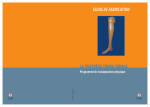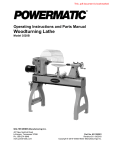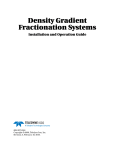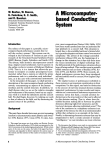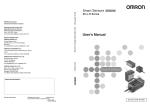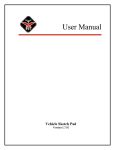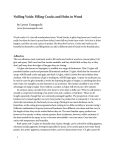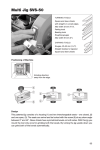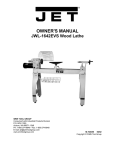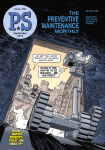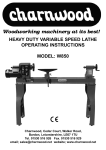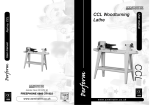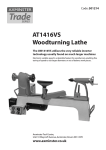Download October 2012
Transcript
Volume 29 President’s Message Issue 10 October 2012 Vic Cohn Coming this November 1, 2012 the OCWA members are going to be asked to decide a direction for next year, 2013 and the years to follow for our club. This may be the first time in OCWA club history that the membership has had a choice of 2 members running for the same office of President. As the current President of the OCWA, this is a great opportunity for me to see if the members want to continue in the direction I have been going for the last year. Our club has grown significantly in size which I am in favor of. I believe that the OCWA should be, as its name implies, an For the Provisional Slate of Association of all Woodworkers in Orange County. I hope that next year Candidates, see page 6. we can begin bringing other local woodworking groups into our Association so that together as a group we will be stronger and better able to face the challenges of going forward. In the coming year I am looking forward to working with our partners at the OC Fair to accommodate their request for a more ‘gallery’ like booth in the display area. One possibility I'm currently pursuing is our having our own booth outside of the gallery where the members will be free to congregate during the fair and we will be able to accept donations and sell our items to raise money for our ongoing activities. Finally, I often said during my 3 years as President of the Turners and during this year as President of the OCWA that I love the leadership role I have in our group. I would like to continue on for at least 1 more year especially IN THIS ISSUE to follow up on the Government requireFor information about the Annual President’s Message 1 OCWA Auction, see page 10. ments for being granted the 501(c) 3 NonProfit Charitable status that myself and Woodworkers’ Sawdust 2 several members of the Board of Directors have been working on for over Woodturners’ Shavings 3 4 years. With your vote to continue as President I will be able to celeCalendar of Events 4 brate with you that long sought after status. Show and Tell 4 Toy Story 5 2012 OCWA Elections 6 The Scrap Bin 6 2012 Auction Rules 10 Meeting Dates 12 - Vic 1 Woodworkers’ Sawdust Drew Shellenbarger Hello woodworkers; September has left the building. Now is it me, or has this year flown by? I’m looking forward to the auction next week. Looks like the online tool sales were successful. If I only had time. We still need to have somebody step up and run for Vice President. I’m not one to make excuses, but I’ve slacked on some of my duties. One, letting you know who the speaker will be. I’m catching a break because of the auction, and looking forward to November. Maybe one of the past speakers who couldn’t make it, I’ll ask back. Also, I could have a new products showcase; let me know at the auction please. September’s speaker was Greg Madrigal. Now for those who chose to stay home because you didn’t want a surprise, you surely missed out. Greg brought in a multitude of joy as he talked about letting go of a 9-to-5 job and doing something he truly enjoys. He makes fly fishing nets: custom made, every one. No two alike. He went into great detail on the processes employed in making these nets; as a matter of fact, two nets he brought to the meeting are destined to be Eric Clapton’s. Another highlight was his acrylic chamber: the one he uses to stabilize the wood. All these years, and not once have we had a speaker talk about this subject. Great show, Greg, and thanks again for sharing your love for woodworking. We’d love to have you back next year to see your progression. Next month—no surprise—AUCTION! See you there; - Drew Welcome - New Members! Geoffrey Bernd Allen Dardenelle Steve Joines Irvine Corona Interest: Woodturning, Toys La Habra Bob Buchanan Rapid City, SD Richard Kalman Scott Catherall Orange Interest: General Woodworking, Woodturning, Hand Tools, Toys, Restoration, Furniture Yorba Linda Vivien Olsen Orange Interest: General Woodworking, Woodturning • CLUB OFFICERS & COMMITTEES • Board of Directors Club Committees President Victor Cohn 562-252-2580 Badges Len Musgrave 714-532-4778 Vice President Drew Shellenbarger 714-450-2365 Nominations Treasurer Ralph Crowther 949-588-2922 Mentor Chairman James Santhon 949-481-2821 Secretary Ed Straub 714-536-4568 Webmaster Larry Marley Turners President Robin Hoff 714-505-2688 Toy Program Public Affairs Larry Marley 949-412-6710 Refreshments Director at Large Bill Rogers 714-637-2912 2nd Director at Large Woodturners Committees Outside Programs Dick Foreman 714-637-6175 Challenge Dick Foreman 714-637-6175 Special Projects Jerry Nininger 949-631-7530 949-412-6710 Pen Projects Victor Cohn 562-252-2580 Bill Rogers 714-637-2912 Audio/Video Ralph Alder 714-614-4461 50/50 Drawing Al Whitcomb 714-931-0555 Resources George Plummer 714-540-4527 50/50 Drawing Bill Rogers 714-637-2912 James Santhon 949-481-2821 Library Ollie Vaughan 949-278-5939 Wood Supplies Jeanette Gonzales 562-417-7750 Past President Craig Chambers 714-761-9245 Welcome Art Dunbar 714-536-4568 Nominating Harold Hardy 562-429-1671 Newsletter David Tilson 714-330-4786 O.C. Fair Ed Straub Nominating Ross Gilroy 714-680-4570 2 Woodturners’ Shavings Robin Hoff The children and grandchildren are back in school and the weather may actually cool enough to get back into the shop and do some woodturning. I was unable to attend the September meeting as I am also involved with a charitable group that has an annual all-day wild game barbeque for 1,300 guys the day after our turner group meeting. My committee of six guys smokes 700 pounds of buffalo ribs for the event. I am sure that Dick Foreman did an outstanding job in my absence and that he will summarize the meeting for all. Thanks Dick. October’s demonstration will feature Sally Ault from San Diego. Sally is an experienced turner. Her demonstration will focus on turned jewelry items. Sally is a frequent student at Anderson Ranch and she has recently demonstrated at the Utah Symposium. This should be an outstanding demonstration and provide loads of ideas for upcoming holiday gifts. In November we plan to have a demonstration on how to turn a happy face. Gee aren’t we always happy when turning? December’s demonstration topic is open and I will ask each of you for ideas at the October meeting. After some consideration I have decided not to seek reelection as the Turner’s group president. As you probably are aware the Wood Turners are a special interest group within the OCWA. For the most part we operate quasi-independently under the umbrella of the larger organization. Ross Gilroy and Harold Hardy are heading up a nominating committee so that we might have our own wood turner’s group election in November. Please consider getting involved. I would be happy to speak with anyone that has an interest. The president of the Wood Turners sits on the OCWA board and has some input as to the overall direction of the organization. With the possible exception of the toy makers I suspect that the wood turners are the most dynamic and actively involved with their hobby and constitute the largest demographic within the OCWA. Certainly they have been a key ingredient in the past OC fair demonstrations as well as other outreach presentations. At the October meeting I will have brochures for the February 2013 Desert Woodturning Symposium. As a committee of one I have declared October to be “Ralph Alder Appreciation Month”. The vote was unanimous. Ralph provides excellent video coverage of all of our turning demonstrations. He, with the help of DVD Librarian Ollie Vaughan, later makes the presentations available in DVD format for all to use and enjoy. He is also there for us when equipment has to be moved or set up. When you see him, take a moment and say thank you. It will cost you nothing and mean a great deal. The OCWA board is having or has had an after action review of the club’s participation in the 2012 Orange County fair. The feared ”fairmageddon” did not occur and thanks to you, woodturner participation was a key to its success. We could always do better but we need your input and suggestions for improvements. Talk to me or any board member. We need your input. BID ON IT- OWN IT THURSDAY OCTOBER 4, 2012. THE AUCTION SALE OF THE YEAR! BIGGER THAN A HURRICANE, MORE EXCITING THAN PICTURES OF KATE MIDDLETON AND A SUPER CHANCE FOR YOU TO DONATE TO THE OCWA THOSE VERY USABLE BUT NOT USED MUCH WOOD WORKING ITEMS AND PICK UP SOME SUPER DEALS ON OTHER ITEMS THAT MIGHT GET USED MORE OR THAT MAY BE DONATED AGAIN NEXT YEAR BY THE NEW OWNER. WHATEVER…BE THERE, HELP THERE. MAYBE AT LEAST BRING SOME BAGS AND BOXES TO HELP OTHERS HAUL AWAY THEIR TREASURES. ALL DONATIONS ARE FINAL. ALL SALES ARE FINAL. THERE ARE MORE RULES ELSEWHERE IN THIS NEWSLETTER. READ AND HEED. Be safe and Keep on Turning, - Robin 3 Show & Tell Photos • MARK YOUR CALENDAR • Annual OCWA Fundraising Auction Tustin Area Sr. Ctr. Oct. 4 Monthly Toy Workshop Woodworking in America Show & Symposium Old Tool Swap Meet @ Laguna Tools Bill Rogers’ House Oct. 6, 9:00 AM Pasadena Irvine Oct. 12-14 Oct. 13 Segmenting Symposium, w/ Malcolm Tibbets Stateline, NV (Tahoe) Oct. 18-21 21st Annual Craftsman Weekend Pasadena Oct. 19-21 John Jordan (Stubby Lathe) @ S.D. Woodturners San Diego Nov. 10 The Woodworking Shows: No LA Shows This Year! Send Complaints to: [email protected] Tustin Area Sr. Ctr. Mesa, AZ OCWT Annual Woodturning Contest Desert Woodturning Roundup 4 Nov. 15 Feb. 22-24 Toy Story Bill Rogers We had 32 people at the September Toy Workshop and our mascot black Lab. We also had helping us a long-time member Bob Buchanan, who now resides in South Dakota. He makes a yearly visit to the OC to visit his kids, who were sane enough to stay in California for the weather. Bob was smart enough to relocate to a low tax state and keep his money. Bob is the one in the center with the dark blue shirt and no hat. We were busy assembling and spraying the keepsake boxes. We were also installing the rubber feet and wings on the push/paddle ducks. George Beach brought a ton of heart boxes to sand and spray. We had some issues with Jerry Nininger this week, and you can see in the photo (right) he was put in time out with a sander at the north end of the yard. Jerry knew what he did was wrong and he worked there for the entire three hours. I hope this will be a lesson to the rest of the group. Don’t forget that if you have a bunch of toys that need hand sanding, bring them to the toy workshop and we can help with that so you can make more toys. We have over 3,000 toys so far and that’s real good considering we have lost Tom Polhamus and two toy makers, namely Paul McGhehey and Roger Balling, have some medical issues. We all extend our best wishes to both of you and get back to your shop as soon as you can. We had a few new people join us for first time and they had a great time and they said they will be back next month. It was a great day and we all had a great time. Our next workshop will be on October 6th from 9 am to noon at Bill Rogers’ home. - Bill Rogers 5 The Scrap Bin: Comments and Editorial Do you have any woodworking-related tips, tricks, news, or comments? Email them to the editor ([email protected]) or write them down and hand them to David at a club meeting. In an Association of woodworkers, every member, even a novice, can contribute something to improve everyone’s knowledge and skill in the craft, be it a new trick or technology, a “learning experience,” or a reminder of an old-school technique. Current 2013 Slate of Directors. (For Election at the November Meeting.) For President Vic Cohn James Santhon For Vice President (Open) For Treasurer Ralph Crowther For Secretary Ed Straub Jerry Nininger For Public Affairs Larry Marley Director at Large (Open) 2013 OCWA Board of Directors Election Slate I am helping the Association as a past OCWA President to fill some of the vacancies in the leadership position for 2013. For 2nd Director At Large (Open) Every association needs every member to contribute in some way to help the association in some way and to give something back. We have many members that have been active members for years and have never stepped forward to give back to the association in any way. Now is the time to do it. We have two great candidates for President in 2013 in Vic Cohn and James Santhon who have both demonstrated they will be a great help for the first time office holder. This year we have three positions that need to be filled. - Len Musgrave Pictures Are the Ultimate Wood Filler: Tips for Getting Better Photos of Your Work (continued from the September issue) In last month’s issue, we looked at the first couple of important tricks to making better photos of your work, including actually reading the camera’s owners manual and finding the right lighting and exposure for the image. So, now that you’ve got your “studio” set up near that window with the sweet northern light... Vice President - To act in the absence of the President and to be responsible for setting up the demonstration program at the monthly general meetings. Director at Large and 2nd Director at Large - Both of these people are responsible to ensure the affairs of the OCWA are conducted in accordance with the bylaws and in the best interest of the members. Next, Find An Angle You Can Work. Much like Alice looking up at the caterpillar sitting atop the mushroom, the ordinary can become extraordinary when simply viewed from a different perspective. Looking down on a table is boring, but looking up at a table is something most of us haven’t done since we were six years old. Several decades down the road, that can be a new and novel experience, given the right table to look at. Please think about it and give me a call to further discuss your interest. Len Musgrave (714) 532-4778 The first thing you must do when photographing anything is to position the camera relative to the subject. The only general rules to this are to keep “up” near the top of the photograph and never allow yourself to just shoot from a standing height if a different angle might look better. Get up high, get down low, get in close, and try a long shot from far away. You might even try a “Dutch” angle, with the 6 You’ve Got To Focus!! horizon tilted off of horizontal, if it suits the subject. This pretty much covers your point of view, but it leads us to another sort of angle. I’m in complete agreement with legendary photographer Ansel Adams, who had a very dim view indeed of blurry, or soft, photographs. If the subject is not in sharp focus, the whole photograph lacks, shall we say, a focal point. After getting a camera and a good lens, the next most important tool for the photographer’s kit is a tripod. Much like a painter’s easel, it holds the canvas (in our case, the image sensor or film) steady and frees the artist to concentrate on more important things. One of the more common causes of blurred photographs is camera shake; the camera was moving during the exposure, so the image leaves a trail across the frame. If you ever think that you can get along just fine without a tripod, try standing absolutely perfectly still sometime, with an arm extended in front of you and a forefinger not quite touching a fixed object. You’ll find that the muscles in your hand and arm are constantly twitching ever so slightly so as to maintain the proper muscle tone. Also, the signals sent to your brain from your inner ear and the soles of your feet are only just so sensitive, so they cause you to drift around just a bit as you maintain your balance. As your pulse travels from your heart and along the brachial artery, your arm moves ever so slightly. Plus, you’re breathing, so that introduces even more movement. In short, you can never hold truly still while you have a pulse, and stopping that would make it rather difficult to operate the shutter release on the camera. While brighter lighting allows shorter exposure times and The left and middle photos are from relatively “normal” eyelevel viewpoints. The third photo was taken with a wide angle of view from right at the level of the tray and just a few inches away from it. Which of these photos grabs your attention best, and why? When you zoom out (or select a shorter focal length lens), the lens takes in a wider angle of view. This can be useful in visually demonstrating spatial relationships: by placing an object very close to the lens, and another farther away, the sense of scale, distance, and perspective is heightened in the photograph. Zooming in (or selecting a longer focal length lens) takes in a far smaller part of the scene and magnifies it, like a telescope. It also tends to “flatten out” the distances between objects placed near to and far from the lens. This is often seen in nature shows and football games, when the ultralong zoom lenses that bring the action in close can also turn a few light snow flurries into a veritable blizzard by visually compressing a few scattered snowflakes into a space that appears to be just in front of the lens. This can also be useful in photographing larger items, such as furniture, because it eliminates the visual distortions of the wider zoom settings and shows the piece more-or-less as it truly is, with all of its parts in roughly correct proportion and not heavily skewed by perspective. The danger here is that anything that is placed behind the subject can visually merge with it in the final photograph, so if you are shooting in a garden, you might find that the tree that was fifty feet behind your china cabinet appears in the photograph to be growing right out of it! On the left, the design on the cap of the pen is the subject, so only enough of the rest of the pen was left in focus to give a sense of what the object in the photograph actually is. This was done by adjusting the camera’s iris settings and by turning the pen relative to the lens to show more or less of the side of the pen in focus. On the right, the bowl is in sharp focus, and the ripples on the pond are just blurry enough to make an interesting but smooth background. Also note the use of back lighting on the bowl: tricky to pull off, but rewarding when it works; the back light creates a nice glow on the rim of the bowl. 7 other modern technologies can help to minimize the effects of the photographer’s shaky grip on the camera, a $40 tripod, or even a 10¢ bag filled with sand or beans, is the cheapest, and by far the most effective and easy-to-use way to get consistently sharp images, especially when shooting close-up to the subject. Also remember to use a remote control or the camera’s two-second delay timer so you don’t blur the image by directly pressing the shutter release button when you make the image. One final tidbit on focus: once you’ve got your subject in sharp focus, remember that everything at the same distance from the camera will also be in sharp focus, including dust, lint, fingerprints, etc. I always give items a rub-down and dusting before shooting, and it’s handy to keep a blower or a can of compressed air handy to shoo away any errant specks of dust just before shooting. It’s always easier to clean up before shooting than it is to “clean up” the image on the computer. On some cameras, there’s another way to get more of the image in sharp focus. SLRs and most fancier point-and-shoot cameras give the photographer the ability to play with the iris setting (also called the aperture or the f-stop), even if it’s buried in some corner of the menu system. Like the iris in our own eyes, the iris in the camera’s lens controls how much light is admitted, but it also affects the sharpness of the image. Focusing The Viewer: The Art Of Composition. Half of what makes art “art” is what is left out. Leaving color out of a photograph forces the viewer to focus on the shapes, textures and contrasting values (light and dark areas) in the photograph. Leaving parts of the image, such as the background, out of focus leads the viewer’s eye to the subject of the photograph, which had darn well better be in tack-sharp focus. Lighting also contributes greatly to a strong composition; if something is not lit, it is not visible, except perhaps as a dark silhouette. As a general rule, the viewer’s eye tends to be drawn toward the brighter parts of an image, so careful lighting can strengthen the composition of a photograph by illuminating the subject in a pool of light while leaving the background more dimly lit. If the iris is set to a small aperture (set to a high fstop number, such as f/22), it can cause the lens to act almost like a pinhole camera, and everything in front of the camera, from near to far, will be rendered more-or-less in focus. This is called depth of focus. The downside to using the iris to increase the lens’ depth of focus is that it also lets less light in, increasing the exposure time. This is something you may need to experiment with to find what setting offers the best balance between sharpness and speed for your camera, but with most SLR cameras and lenses, the old advice to aspiring photojournalists still holds true: f/8 and be there. Finally, it’s important to select a background for your photo that works well with your subject. A very busy background or a background that can blend with or appear to merge with the subject are things to avoid. Sometimes, all that is needed is to blur the background by throwing it out of focus, or you could shift the camera and rotate the subject until a more suitable background appears behind it. More on the art of composition… As a woodworker and the builder of the subject you’re photographing, it may be difficult to separate it in your mind into its component shapes and colors and see it as something other than what it was made to be, say, as an abstract artwork. If you can find a way to do this, however, you may be able to make some startling detail images of your work, the kind that grab a viewer’s attention and make him or her wonder, “what is that?” In the photo at left, the color and texture of the sawdust overwhelms the pen. In the middle photo, the white background is simply too boring. The coarse canvas background of the last photo enhances the color and texture of the pen, while still remaining less visually interesting, as a background should. Also note that the pen is always placed diagonally in the frame. The basic elements of the visual arts are shape (and texture), color, pattern, and movement. Breaking an object down into these components allows the photographer to more easily find the 8 to tear everything down until I’ve got everything I’ll need. compositions that will hold the most interesting details and most effectively hold the viewer’s attention. A Brief Note On Digital Files While many photographers debate the advantages and disadvantages of using RAW versus JPEG and other files for their photos, the simple fact is that that stuff makes precious little difference to the actual photograph. The one thing to know about digital files and photography is this: a larger image file contains more information, and that means more detail in the resulting photograph. I always photograph with my camera set to make the largest image; in my case that’s 10.1 megapixels. I can always save a copy and trim the copied file down for emails and posting on the web, but if I set the camera to the “small” setting, I will never be able to get back the detail and quality lost from the image. Anyway, memory is dirt cheap these days: I recently got a 16 gigabyte flash drive the size of my thumbnail for under $40. That’s enough space to hold about 800 photos at my large image setting, so there’s no reason to cheap out on memory or to allow yourself to be tempted to save room on the camera’s card by using smaller images. Converging lines in this composition lead the eye towards the subjects: the contrasting maple keys on the corners, and the hinge. I’ll even bet that you wouldn’t have noticed the finger groove on the bottom edge of the box if I didn’t mention it! Finally, “Work” The Subject. For small, simple items such as pens I’ll shoot from two to four different viewpoints, and for bigger items like furniture I’ll shoot at least six different views. Each view is shot with several variations of lighting, focus and composition of objects within the image frame, so the entire photo shoot may produce a total of thirty frames. I find it’s generally easiest to work from big, overall pictures, both with and without a model for “personal interaction,” right down to detail shots and super close-ups of joinery, drawer pulls and dovetails; inlay designs, etc. I try to get enough shots that, even without the original working drawings, I could reproduce the project from the photos (after all, I might sell it or give it away, and then get a request for another). At any rate, with digital cameras and terabyte-sized hard drives, the “film” is pretty much free these days. Also, more shots to choose from means a greater chance of getting a really great photo out of the lot. Further Reading: Kurt Herzog wrote a fine article on the basics of photographing your work that appeared in the April, 2012 issue of Woodturning Design magazine ($6.99). The website WikiHow.com is a free, encyclopedic “user manual” on just about everything. The article How to Take Better Product Photographs for Free details both the photographic process and postproduction for clean, professional-looking product photos. Want to get a bit more advanced? Check out the Tabletop Studio online store and how-to. They have both the gadgets and the how-to tips to get some really slick product pics. Once the pictures are opened on my computer, I can view them full screen and with “fresh eyes.” I’ll weed out the duds and any frames that might show the project in a less-than-rosy light, and I may even go back and re-shoot one or more views if necessary until I get the lighting and focus just right. That’s a big advantage of having a digital camera: I can review the photos while I’ve still got my “photo studio” set up in the other room and there’s no need Missed part of the article? You can find the whole thing in the online edition of Sawdust & Shavings at www.ocwoodworkers.com, or find this and other topics at my online resource, The Woodworking Reference Library. - David Tilson 9 2012 OCWA Auction Rules der's tally of items secured by the auction process. The top part of the Bidder's Number Placard has an area to record the lot numbers of items one wishes to bid on. It also has an area to record the lot numbers won and the bid value accepted by the Auctioneer. The data recorded by the Spotter on the Lot Number Tags will take precedence over any data recorded by the bidder. Auction 2012 - October 4, Tustin Senior Center Lot Number Tags will be attached to each item/lot accepted at the sign-in table for the auction. For each item being auctioned, print the name of the donor and a short description of the item/lot on the Lot Number Tag. Secure the tag to the item/lot. Place the Tagged item on one of the auction tables. Items not deemed to be worth more than $20 will be evaluated by the Spotters and placed on one of the appropriate "Yard Sale" tables. There will be a $1 table, a $5 table, a $10 table and a $15 table. This means that any item on that table may be had for the table price. Monies will be collected at the time of selection and sale by the table manager. These will be cash only tables. Only bills of $20 or less will be accepted. Again, bring small bills. Here’s the latest on the Auction of Woodworking tools in place of the regular October OCWA General meeting. The Auction will be held at the Tustin Area Senior Center, in the Auditorium. The key times for this event are: 5:00 to 7:00 PM Drop off items and Bidder Sign in. 7:00 to 9:30 PM Auction and Yard Sale. 9:30 to 10:00 PM Cash out Winning Bidders. The event this year will consist of three major activities. The primary activity will be the auction of items valued above $20. The secondary activity will be the sale of those items valued below $20. There will be a $1.00, $5.00, $10.00, $15.00 and a price as marked table set up in the auditorium for your immediate cash purchase. The third activity will be the Silent Auction. All bids are final and all items are accepted "As Is". There will be no refunds possible. Each Bidder's tally may be paid by cash, check or credit card. All checks should be made payable to "OCWA". If possible please bring a supply of small bills ($1, $5, $10, and $20) for the cash sale tables. A Silent Auction Card will be issued for those items scheduled for the silent auction table. The donor's name and a short description of the item will be recorded on the card. The card will be affixed to the table or item so that bids may be recorded on the card. The highest bid entered on the card at the cut off time will be the winning bid. The Silent Auction Cards will be collected by the Spotters and given to the Recorders for addition to the bidder's tally. The seller will be paid 75% of the winning bid as their Bidders, during the Auction, will be identified by a Bidder's Number Placard issued at sign-in time. The Bidder's name and telephone number will be printed on the bottom of the placard. The bottom portion of the placard will be retained by the Recorders where they will be used to track the bid10 2012 OCWA Auction Rules... ...And a Parting Shot The (Mostly True) Story of the Laughing Tree share of the bid price, but only following the collection of all money due the OCWA for regular auction items. The auction proper will begin at 7:00 PM in the Auditorium of the TASC. Bids will be accepted in whole dollar value increases only. The Spotters will record the winning bidder number and amount accepted by the Auctioneer on the bottom of the Lot Number Tag. If auction items are small they will be handed to the winning bidder directly. Larger items will be retained for later pickup. The bottom portion of the Lot Number Tag will be delivered to the Recorders for addition to the bidder's computer tally. This is the tree I like to call The Laughing Tree. It’s a desert ironwood, or tesota (Olneya tesota), that happens to be growing right smack on top of the San Andreas fault in southern Riverside County. As the story goes, a geologist who was studying the fault nearby noticed the tree, and reasoned that the shearing movement of the fault couldn’t help but damage the tree’s root system when the fault would let loose with a big quake. This would result in stress to the tree that would show as compressed growth rings (at least on one side) in the years immediately following the earthquake. Knowing that most desert plants, and especially ironwood trees, are very long lived, he decided to have a dendrochronologist take a core sample from this tree to see if he could find dates for previous large earthquakes on the San Andreas recorded in its annual rings. All items brought to the auction will be considered as being donated to the OCWA with all proceeds going to the OCWA. The exception to this is the Silent Auction Items. The seller of those items will receive payment for 75% of the money collected by the Recorder after all other money has been collected. Following the completion of the final item auctioned, the Recorders will determine the final tally of all bidders so that each bidder may then pay his/her total. Little did he know what sort of tree this ironwood is. As I was told it, they broke off two expensive Swedish core drills, and the handle as well, trying to get their sample. Failing in this, they next attempted to remove a large limb with a chainsaw to get a “pancake” sample. After a great shower of smoke and sparks, the chainsaw was destroyed, having left a cut only an inch deep in the branch. They finally gave up in their quest, and the tree is still thriving, and laughing, atop the fault to this day. Now that’s some tough wood! Please, Please, Please don’t ask to check out early. It is very hard for the Recorders to stop what they are doing. If you must leave early, please ask a fellow club member to pay for and bring home your items. (It might work best if you leave money to cover your purchases with that fellow member.) - David Tilson 11 Sawdust & Shavings Is The Monthly Newsletter of The Orange County Woodworkers Association P.O. Box 1038 Fullerton CA 92836-8038 Visit us on the Web at: OCWoodWorkers.com Sawdust & Shavings is published monthly before the Woodworkers Meeting. The deadline for submissions is the Monday after the Turner’s meeting. Do you have an idea for an article, shop tip, or tool review? Please contact the editor at: ADDRESS CORRECTION REQUESTED [email protected] WHERE? Tustin Senior Center 200 S. “C” Street Tustin, CA 92680 WHEN? Woodworkers’ Meeting Thursday Oct. 4, 7:00 PM Woodturners’ Meeting Thursday Oct. 18, 6:30 PM Board Meeting Thursday Oct. 4, 6:00 PM Friends of OCWA — Anderson International Trading Please Support Our Sponsors Deft, Inc. Laguna Tools Rockler Woodworking & Hardware www.DeftFinishes.com (800) 234-1976 www.LagunaTools.com (714) 282-1157 www.Rockler20.com Austin Hardwood & Hardware Exotic Woods USA Reel Lumber Service Festool (714) 953-4000 www.th-h.com (631) 651-8651 www.ExoticWoodsUSA.com (714) 632-1988 www.ReelLumber.com www.FestoolUSA.com Craft Supplies, USA Industrial Blade & Products Co. Renaissance Doors & Windows Woodcraft Supply (888) 283-0722 www.IndustrialBlade.net RenaissanceDoorsAndWindows.com (714) 899-1422 www.Woodcraft.com (800) 454-6270 www.AITWood.com (800)551-8876 www.WoodturnersCatalog.com












